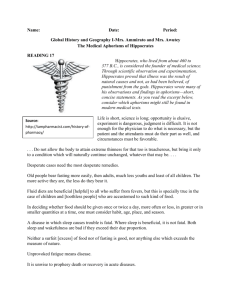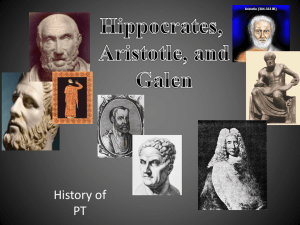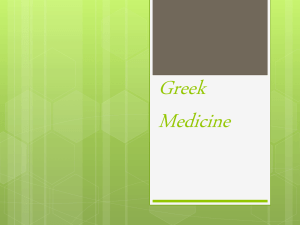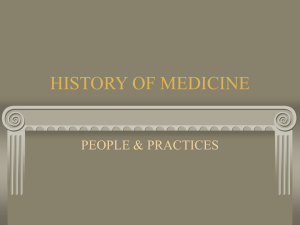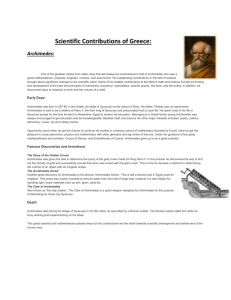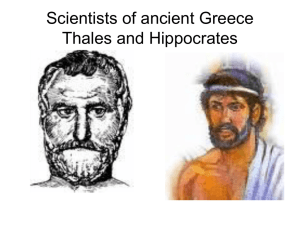References to Anesthesia, Pain, and Analgesia in the Hippocratic
advertisement
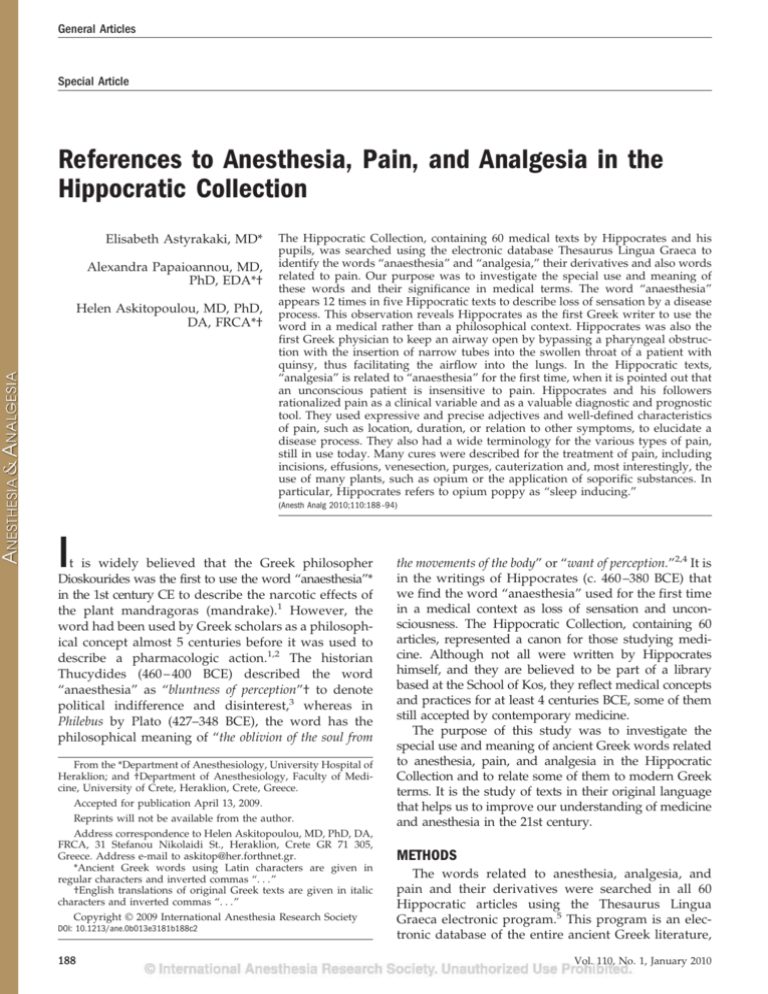
General Articles Special Article References to Anesthesia, Pain, and Analgesia in the Hippocratic Collection Elisabeth Astyrakaki, MD* Alexandra Papaioannou, MD, PhD, EDA*† Helen Askitopoulou, MD, PhD, DA, FRCA*† The Hippocratic Collection, containing 60 medical texts by Hippocrates and his pupils, was searched using the electronic database Thesaurus Lingua Graeca to identify the words “anaesthesia” and “analgesia,” their derivatives and also words related to pain. Our purpose was to investigate the special use and meaning of these words and their significance in medical terms. The word “anaesthesia” appears 12 times in five Hippocratic texts to describe loss of sensation by a disease process. This observation reveals Hippocrates as the first Greek writer to use the word in a medical rather than a philosophical context. Hippocrates was also the first Greek physician to keep an airway open by bypassing a pharyngeal obstruction with the insertion of narrow tubes into the swollen throat of a patient with quinsy, thus facilitating the airflow into the lungs. In the Hippocratic texts, “analgesia” is related to “anaesthesia” for the first time, when it is pointed out that an unconscious patient is insensitive to pain. Hippocrates and his followers rationalized pain as a clinical variable and as a valuable diagnostic and prognostic tool. They used expressive and precise adjectives and well-defined characteristics of pain, such as location, duration, or relation to other symptoms, to elucidate a disease process. They also had a wide terminology for the various types of pain, still in use today. Many cures were described for the treatment of pain, including incisions, effusions, venesection, purges, cauterization and, most interestingly, the use of many plants, such as opium or the application of soporific substances. In particular, Hippocrates refers to opium poppy as “sleep inducing.” (Anesth Analg 2010;110:188 –94) I t is widely believed that the Greek philosopher Dioskourides was the first to use the word “anaesthesia”* in the 1st century CE to describe the narcotic effects of the plant mandragoras (mandrake).1 However, the word had been used by Greek scholars as a philosophical concept almost 5 centuries before it was used to describe a pharmacologic action.1,2 The historian Thucydides (460 – 400 BCE) described the word “anaesthesia” as “bluntness of perception”† to denote political indifference and disinterest,3 whereas in Philebus by Plato (427–348 BCE), the word has the philosophical meaning of “the oblivion of the soul from From the *Department of Anesthesiology, University Hospital of Heraklion; and †Department of Anesthesiology, Faculty of Medicine, University of Crete, Heraklion, Crete, Greece. Accepted for publication April 13, 2009. Reprints will not be available from the author. Address correspondence to Helen Askitopoulou, MD, PhD, DA, FRCA, 31 Stefanou Nikolaidi St., Heraklion, Crete GR 71 305, Greece. Address e-mail to askitop@her.forthnet.gr. *Ancient Greek words using Latin characters are given in regular characters and inverted commas “. . .” †English translations of original Greek texts are given in italic characters and inverted commas “. . .” Copyright © 2009 International Anesthesia Research Society DOI: 10.1213/ane.0b013e3181b188c2 188 the movements of the body” or “want of perception.”2,4 It is in the writings of Hippocrates (c. 460 –380 BCE) that we find the word “anaesthesia” used for the first time in a medical context as loss of sensation and unconsciousness. The Hippocratic Collection, containing 60 articles, represented a canon for those studying medicine. Although not all were written by Hippocrates himself, and they are believed to be part of a library based at the School of Kos, they reflect medical concepts and practices for at least 4 centuries BCE, some of them still accepted by contemporary medicine. The purpose of this study was to investigate the special use and meaning of ancient Greek words related to anesthesia, pain, and analgesia in the Hippocratic Collection and to relate some of them to modern Greek terms. It is the study of texts in their original language that helps us to improve our understanding of medicine and anesthesia in the 21st century. METHODS The words related to anesthesia, analgesia, and pain and their derivatives were searched in all 60 Hippocratic articles using the Thesaurus Lingua Graeca electronic program.5 This program is an electronic database of the entire ancient Greek literature, Vol. 110, No. 1, January 2010 Table 1. The Word “Anaesthesia” and Its Derivatives, Their Explanation in English and the Citations in the Hippocratic Collection Where These Words Appeara Derivatives of the word “anaesthesia” Explanation in English Citation “Anaesthesia” 关␣␣ι␣兴 (2) Noun, meaning: loss of sensation, unconsciousness “Anaesthetos” 关␣␣ι兴 (5) Adjective, meaning: senseless “Anaesthetos” 关␣␣ 兴 (3) Adverb, derived from the adjective “anaesthetos” 关␣␣ι兴 Noun, dative in plural, derived from the adjective “anaesthetos” 关␣␣ι兴, in ionic form Neuter comparative adjective of “anaesthetos” 关␣␣ι兴, meaning: less sensitive “Anaesthetoisi” 关␣␣ 兴 (1) “Anaesthetotera” 关␣␣o ⑀␣兴 (1) a Coan Prenotions, 466.1 Letters, 10th Letter, line 43 Breaths, 13.3 & 14.44 Epidemics, 7.1.1.21 Coan Prenotions, 395.3 Use of Liquids, 1.27–33 Epidemics, 3.3.17.12 & 3.3.17.15 Coan Prenotions, 621.8 Letters, 17th Letter, line 291 Ancient Medicine, 15.25 In brackets 关. . .兴 is given the original Greek spelling in the monotonic system, and in brackets (. . .) the total number of times each word appears. itemizing the works of all classic authors. The database includes search options for a combined search. For example, a particular word can be sought in a particular work, author, or in all classic literature, and the program automatically provides the number of citations together with the relevant text. Specifically, the words “anaesthesia” [␣␣ι␣],‡ “analgesia” [␣␣␥ι␣], and the ancient Greek words Hippocrates used most frequently for pain, such as “algos” [␣´␥], “algema” [␣´␥␣], “odyne” [␦´], and “ponos” [ó] were sought in all 60 Hippocratic article. In the word search mode, there are options such as “exact word,” “prefix,” “suffix,” and “any.” We used the “any” mode and entered only the prefix of the words to be searched, to find citations that also include words with common roots, compound words, or words stemming from the particular words. For example, we entered the prefix [␣␣] for “anaesthesia” related words, and [␣␥], [␣␣␥], [␦´], and [ó] for the words “algos,” “analgesia,” “odyne,” and “ponos,” respectively. The relevant citations were then examined in the original Greek texts and compared with classic English translations. RESULTS The word “anaesthesia” and its derivatives appear only 12 times in five Hippocratic texts (Table 1). “Algos,” the ancient word for pain, is also mentioned only 14 times, in contrast to words stemming from it that are very common, appearing 483 times (Table 2). Such words are the verb “algeo” and its derivatives and the very common adjective, still in use, “algeinos,” and compound medical terms such as “kardialgia,”6a “hysteralgia,”7a “cephalalgia,”8a and “osphyalgia”9a (Table 3). The contemporary term “analgesia” derived from the words “algos” and “algeo” and the privative prefix “an” does not appear as such in the Hippocratic Collection. Its derivatives, the adjectives “analgetos”10a,11a ‡Ancient words using Greek characters and in the monotonic system are given in brackets [. . .]. Vol. 110, No. 1, January 2010 and “analgea”12 appear four times. In contrast to “algos,” a common word for pain in the Hippocratic texts is “odyne” (pain of body and pain of mind),13 appearing almost 884 times as such or as a compound word such as the adjectives “epodynos”6b and “anodynos.”11b “Ponos” is also a very common medical term, appearing about 722 times (Table 2). DISCUSSION Use of the Word “Anaesthesia” and Its Derivatives by Hippocrates The search of the articles of the entire Hippocratic Collection revealed that the word “anaesthesia” was first used in a medical context, as loss of consciousness and sensation, by Hippocrates (c. 460 –380 BCE). In the work Breaths, the word “anaesthetos” (senseless) acquires the medical meaning of loss of sensation, when Hippocrates writes: “For when they [breaths] pass through the flesh and puff it up, the parts of body affected lose the power of feeling [“anaestheta”§]”10b (Table 1). It is from the Greek adjective “anaesthetos,” still in use today, that the word “anaesthesia” was derived, in the same way as “analgesia” was derived from the adjective “analgetos” (not sensing pain).2 In the same work, “anaesthesia” is related to “analgesia” for the first time, when it is stated that an unconscious patient is also insensitive to pain: “At this time the patients are unconscious [“anaesthetoi”§] of everything, deaf to what is spoken, blind to what is happening and insensible to pain [“analgetoi”§].”10a However, both words express loss of feeling and pain insensitivity caused by a disease process rather than from a pharmacologic action. Another example described in the work Epidemics is the case of a patient who “took no notice [“anaesthetos”]” of his symptoms on the seventeenth day of his fatal disease.14a Again, the loss of consciousness is related to a fatal outcome. It is remarkable how Hippocrates recognizes the consequences of a serious §The endings “a,” “oi,” and “ai” indicate plural forms. © 2009 International Anesthesia Research Society 189 Table 2. The Most Frequently Used Words for Pain and Their Derivatives, Their Explanation in English and the Main Works of the Hippocratic Collection Where These Words Appeara Words related to pain “Algos⬙ 关␣´␥兴 (14) Their derivatives Noun “algema” 关␣´␥␣兴 (194) Noun “algedon” 关␣␥␦ 兴 (13) Adjective “algeinos” 关␣␥⑀o 兴 (2) Verb “algeo” 关␣␥ 兴 (185) “Odyne” 关␦ 兴 (772) “Ponos” 关o 兴 (498) a Past participle of the verb algeo “algesas” 关␣␥ ␣兴 (4) “Proalgesas” 关␣␥ ␣兴, past tense participle of the verb “proalgeo,” derived from the preposition “pro” and the verb “algeo” (4) Noun “analgesia” 关␣␣␥ι␣兴 derived from the words “algos” and “algeo” and the privative prefix “an” Adjective “analgetos” 关␣␣´␥兴, derived from the privative “an” and “algos” (3) Adjective “analgea” 关␣␣´␥⑀␣兴, derived from the privative “an” and “algos” (1) Verb “odynao” 关␦␣´兴 (51) Noun “odynema” 关␦ ␣兴 (5) Adjective “odyneros” 关␦o 兴 (2) Adjective “odynodes” 关␦ ␦兴 (54) Adjective “epodynos” 关⑀ ␦兴 , derived from the preposition “epi” and odyne (53) Adjective “anodynos” 关␣ ␦兴, derived from the privative “an” and odyne (50) Verb “poneo” 关 兴 (224) Explanation in English Pain felt or caused, suffering Pain, suffering of body or mind, grief Painful, grievous To feel bodily pain, to suffer, to feel pain of mind Smarting with pain Main Hippocratic works in which these words appear Epidemics (81) Coan Prenotions (88) Prorrheticon (38) Feel pain beforehand Absence of sense of pain Free of pain Painless Cause one pain or suffering Pain Painful, distressing Painful Painful Epidemics (180); Diseases I–III (141); Diseases of women (116); Internal affections (69) Painless Work hard, suffer, toil in praying, toil in fight, to be busy with, suffer from illness, be sick, work hard at, make or do with pains or care, afflict, distress Epidemics (112); Aphorisms (28); Coan Prenotions (84) In brackets 关. . .兴 is given the original Greek spelling in the monotonic system, and in brackets (. . .) the total number of times each word appears. Table 3. Compound Medical Terms of the Word “algos” in the Hippocratic Collectiona Compound words from the word “algos” and the verb “algeo” “Gonyalgia” 关␥␣␥ι␣兴 (2) “Dialges” 关␦␣␥ 兴 (1) “Kardialgia” 关␣␦␣␥ι␣兴 (23) “Cephalalgia” 关⑀␣␣␥ι␣兴 (63) “Osphyalgia” 关␣␥ι␣兴 (6) “Hysteralgia” 关⑀␣␥ι␣兴 (1) Derived from “Gony” 关␥o 兴b and the verb “algeo” 关␣␥ 兴 The preposition “dia” 关␦␣兴 and “algos” 关␣´␥兴 “Kardia” 关␣␦ι␣兴b heart and the verb “algeo” 关␣␥ 兴 “Cefale” 关⑀␣ 兴b and the verb “algeo” 关␣␥ 兴 “Osphys” 关 兴b and the verb “algeo” 关␣␥ 兴 “Hystera” 关 ␣兴b and the verb “algeo” 关␣␥ 兴 Explanation in English Main Hippocratic works in which these compound words appear Pain in the knee Epidemics (2) Grievous Diseases I–III (1) Suffering from heartburn Epidemics (11); Coan Prenotions (8); Prorrheticon (3) Headache Coan Prenotions (31); Prorrheticon (16); Epidemics (7) Coan Prenotions (5); Prorrheticon (1) Lumbago, back pain Pain in the womb Regimen in Acute diseases (1) a In inverted commas “. . .” are given the original Greek words in Latin characters, in brackets 关. . .兴 the same words in Greek characters in the monotonic system, and in brackets (. . .) the total number of times each word appears. b Explanation in English of the prefix words used: “gony” ⫽ knee; “kardia” ⫽ heart; “cefale” ⫽ head; “osphys” 关 兴 ⫽ back; “hystera” 关 ␣兴 ⫽ womb. 190 Anesthesia, Pain, and Analgesia in Hippocrates ANESTHESIA & ANALGESIA illness with a fatal outcome. In Coan Prenotions, a patient with inflammation of the lungs and heart is paralyzed [“paraluetai”] completely, lies frozen, and senseless [“anaesthetos”] and eventually dies on the second or third day.9b In the same work, he remarks that any evacuation which takes place without the patient sensing it [“anaesthetos”] is fatal.9c Another interesting clinical observation of an untoward effect that leads to a coherent and practical suggestion is found in the work Use of Liquids. Hippocrates describes the use of warm water as a cure and suggests that the water should not be hotter than the patients can tolerate, “except in cases of loss of speech, paralysis, numbness [“nenarkomenoisin”] or anesthesia [“anaestheta”],” otherwise the doctor may cause burns without realizing it.15 In these lines, we find the Greek word “nenarkomenoisin” which is a passive perfect participle of the verb “narkoo” (to grow numb), from which “narcosis” is derived, next to the word “anaestheta.” In one of his best-known works, Ancient Medicine, Hippocrates attributes to inanimate objects, like “a leathern or wooden vessel” the human properties of being “less sensitive [“anaesthetotera”] than man . . .” to the effect of “hot or cold and astringent or insipid” things.16 Components of Contemporary “Anaesthesia” in the Hippocratic Collection Although Hippocrates does not refer to pharmacologic anesthesia and its different aspects, he knows that some substances can induce sleep. Most interestingly, in Epidemics the word “hypnikon” (producing sleep) is found, derived from the word “hypnos” (sleep), from which the contemporary word hypnosis originates.13 Hippocratic doctors used the word “hypnikon” to describe soporific substances applied to patients with toothache.6c A related word “hypnoticon,” still used in modern Greek, from which the term hypnotic is derived, is found in the work Diseases of Women in which Hippocrates refers to “meconium” (opium poppy) as “sleep producing” [“hypnotikon”].17 Hippocrates in his writings also refers to some fundamental components of contemporary anesthesia, such as airway protection, the state of sleep and the term “narcosis.” In one of his best-known works, Diseases III, he describes the insertion of narrow tubes into the swollen throat of a patient suffering from “kynanche,” the Greek word for quinsy. “With angina [“kynanche”], as it is called, the person chokes and seems to have something like an apple caught in his throat.” As a treatment, the author suggests that the doctor “must also clean out the lower cavity with medication or enema, and insert tubes [“avliskoi”] into the throat behind the jaws, in order that air may be drawn into the lung.”18a We may assume that these tubes that kept an open airway must have been premature types of a nasopharyngeal airway or even a tracheal tube. In this case, Hippocrates might be the first ancient Greek physician to Vol. 110, No. 1, January 2010 manage the airway by bypassing a pharyngeal obstruction and facilitating the airflow into the lungs. In the Hippocratic work Coan Prenotions, the word “narke” (temporary decline or loss of senses and movement), from which the word “narcosis” (state of unconsciousness or drowsiness produced by a drug) was later derived, is used jointly with the word “anaesthesia.” In this work, Hippocrates states that when unaccustomed numbness and loss of sensibility, “narkai . . . and anesthesiai,” are present in a patient suffering from strangulating ileus, this is a warning sign of “apoplexy.”2,9d In Aphorisms, “narke” is also used to describe physical “numbness” and also “dullness of intelligence.”19a,b The philosophical issue of sleep was explored extensively by ancient Greek scholars including Aristotle. Hippocrates approached the issue from the physiologist’s perspective. He had noticed that during sleep the body cannot perceive external stimuli, and it is the soul, the contemporary subconscious state, which not only keeps its functions but also even takes over those of the body. In the work Dreams, he clearly differentiates the state of sleep from the waking state: “The body when asleep has no perception; but the soul when awake has cognizance of all things, sees what is visible, hears what audible, walks, touches, feels pain, ponders. In a word, all the functions of the body and of soul are performed by the soul during sleep.”20 However, he only refers to natural sleep and not pharmacologic sleep. This can be explained by his opposition to surgery, which he left to other practitioners. The Hippocratic Oath unambiguously states: “I will not use the knife, not even, verily, on sufferers from stone, but I will give place to such as be craftsmen therein.”21 This interdiction against the knife explains why in the Hippocratic Collection there is not a single reference to the use of soporific plants or opium to calm the acute pain of surgery. However, Hippocrates must have known the properties of those substances and often used them for the treatment of pain, as we will see later. Even though Hippocrates did not describe anesthesia with the word “anaesthesia” as it is defined today, he was the first to use this word in a medical context to describe loss of consciousness and sensation. Five centuries later, Dioskourides used this word to describe the absence of sensation caused by drugs.1 Finally, more than 2000 years after Hippocrates, Oliver Wendell Holmes in a moment of inspiration, very accurately, used this word to describe a state closer to the modern definition and understanding of clinical anesthesia. The Vocabulary of Pain in the Hippocratic Collection Hippocratic physicians developed a rich vocabulary for pain in which the physical and moral elements overlap. There are numerous citations throughout the Hippocratic Collection describing and differentiating between painful conditions. The words and their derivatives most frequently used by Hippocrates are “algos,” “algema,” “odyne,” and “ponos” (Table 2). © 2009 International Anesthesia Research Society 191 Table 4. Adjectives Describing the Different Types of Pain in the Hippocratic Collection and Their Explanation in Englisha Adjectives for pain “Deine” 关␦⑀ 兴 “odyne” “Ischyri” 关 兴 “odyne” Explanation in English “Karebarike” 关␣␣ 兴 “odyne” Fearful, terrible pain Powerful, forcible, violent, severe pain Pain causing heavy head “Oxeia” 关⑀ι␣兴 “odyne” Acute, sharp pain “Sphodros” 关␦o 兴 “ponos” Vehement, violent, excessive, severe pain Cold pain, in the sense of old and chronic Warm pain, in the sense of recent “Psychrai” 关␣ι兴 “odynae” “Thermai” 关⑀␣ι兴 “odynae” a Main Hippocratic works in which these adjectives for pain appear Epidemics (book 7, section 5) Epidemics (book 2, section 5, paragraph 2); Internal Affections (section 14) Epidemics (book 3, chapter 3, case XII); Coan Prenotions (section 164) Coan Prenotions (section 514); Internal Affections (section 28) Regimen in Acute Diseases (Appendix, section 55) Epidemics (book 6, section 1, paragraph 7) Epidemics (book 6, section 1, paragraph 7) In brackets “. . .” are given the original Greek words in Latin characters, in 关. . .兴 the same words in Greek spelling in the monotonic system and in (. . .) a specific citation for each work. Some of them, still in use in modern Greek, are also found as loans in compound words in other languages. In the Hippocratic Collection, “algos” represents a more general type of suffering involving the whole body, which is prolonged and susceptible to recurrence.22 The word “algema,” like “algos,” is used for a more general type of pain, such as “chronic pain in the loins,” “pains of the forearms and the neck,” or even to differentiate between types of headache.8b– d “Odyne” describes acute, sharp, and localized pain and intense mental pain.2,22 In Epidemics “odyne” is used to explain “pain in the left ribs”6d or “pain in the right hypochondrium.”14b The compound word “epodynos” (painful) is used to describe painful areas of the body like a “painful sprain behind the thumb.”6b “Ponos,” the modern Greek word for pain, originally meant labor and hard work in the Homeric epics. This meaning may have originated from the personification of “Ponos” (Toil) and “Algea” (Sorrows) as children of the hard-hearted goddess “Eris” (Strife) in Greek mythology.23 Much later, the consequences of labor or distress were described as “ponos” in which case it meant physical pain.24 However, it was Hippocrates who used the word to describe the physical pain caused by disease, such as pain in the joints.19c “Ponos,” like “algos” describes a more general type of pain (Table 1), for example, “heaviness in the bowels with pain,” “painful, continuous, acute fever,” or “chronic and painful, watery inflammations of the eyes.”14c The Significance of Pain as a Diagnostic and Prognostic Tool Hippocrates was the first physician to rationalize pain and use it as a valuable diagnostic and prognostic tool. He considered pain in relation to the overall clinical picture of the patient and not as an isolated symptom. He used the clinical features of pain as important manifestations in the disease process and as a major tool to outline the prognosis and severity of an illness. Numerous citations throughout the Hippocratic texts testify to this. For example, Hippocrates noted the time when the pain starts, to elucidate the 192 Anesthesia, Pain, and Analgesia in Hippocrates course of the pathogenic process: “. . . pains and fevers occur when pus is forming rather than when it has been formed”19d or, in the case of consumption in the Epidemics, “in the majority of these cases the throat was painful throughout from the beginning”14d When two different, distinct pains occurred simultaneously, he related the most intense one to the more serious illness: “when two pains occur together, but not in the same place, the more violent obscures the other.”19e The anatomical location of the pain was an important diagnostic sign. In Prognostics, for example, pain accompanied by tachypnea indicated ailments in the chest: “rapid respiration indicates pain or inflammation in the parts above the diaphragm.”25a Also, in Aphorisms it is pointed out that “pains and swellings of the belly are less serious when superficial, more severe when deep – seated.”19f Specific features of pain, such as duration, intensity, location, or depth, were sought and scrutinized to determine the fatality or seriousness of a disease: “Violent and continuous headaches, should there be in addition one of the deadly signs, is a very fatal symptom . . .”25b or “pains occurring with fever in the region of the loins and lower parts, if they leave the lower parts and attack the diaphragm, are very mortal.”25c To explain, emphasize or differentiate among the different manifestations of pain, Hippocrates complements these terms with precise adjectives, such as “oxeia odyne,”25d or “ischyros ponos”14e (Table 4). Nonpharmacologic and Pharmacologic Cures for Painful Conditions in the Hippocratic Texts In the Hippocratic Collection, many different nonpharmacologic cures for painful conditions are described, such as diet, heat, cold, ablution, purging, cauterization, expectoration, venesection, incisions for pleurisies, or hot effusions for headaches. Some of them are quite bizarre by modern medical standards. For example, in the Aphorisms, the opening of a vein, “phlebotomy” (venesection), was suggested for curing headaches: “Pains at the back of the head are relieved by opening the upright vein in the forehead.”19g Again, in a patient with delirium and “aphonia” (loss of voice) ANESTHESIA & ANALGESIA who suffered from pains in the heart, “phlebotomy stopped these pains.”6e For gastrointestinal pains, a common treatment was purging. “Pains above the diaphragm indicate a need for upward purging; pains below indicate a need for downward purging.”19h Rest plays a major role in the relief of pain: “In every movement of the body, to rest at once when pain begins relieves the suffering.”19i In certain sections of the Hippocratic work great emphasis is placed on therapies in which opposites cure opposites and like curing like. In Places in Man, it is explained that “pains are cured by opposites.” In the same passage it is stated that, “sometimes conditions can be treated by things opposite to those from which they arose, and sometimes by things like to those from which they arose.”26a It is worth wondering whether these observations were the forerunner of later discoveries about activation or deactivation of facilitating or inhibiting mechanisms during nociception. In addition to nonpharmacologic cures, Hippocratic physicians also used the different properties of various substances. In Places in Man, it is clearly stated that “all substances that change the state of a patient are medications [‘pharmaka’].”26b In the Hippocratic Collection, 236 distinct plants are mentioned. Most of them have soporific, narcotic, or poisonous properties, such as mandrake, henbane (Hyoscyamus), nightshade, and especially poppy.27 In the work Fistulas, it is suggested that a patient with anal inflammation and protrusion should “drink white meconium” (white poppy) if the pain does not subside by other means.28 In Diseases III, for pain in the hypochondrium due to pleurisy, it is suggested to give the patient white opium poppy to drink with other substances, such as “cumin, flower of copper, honey, vinegar, water” and others.18b The opium extracts in the Hippocratic texts were mainly prescribed for painful gynecological ailments.29,30 Other substances used for the same painful conditions include silphium (a sort of asafetida),30 cumin with honey, leek,30 cyclamen,30 and many others. In Regimen in Acute Diseases, the author suggests the use of black hellebore (Helleborus niger) and peplium (Euphorbia peplus or petty spurge) as purgatives that stop the pain, in combination with daucus (Athamanta cretensis), seseli (Laserpitium latifolium or laserwort), anise, and juice of silphium.7b CONCLUSIONS The study of the Hippocratic Collection in the original Greek language revealed Hippocrates as the first physician to use the words “anaesthesia” and “analgesia” in a medical context. His realistic approach to health and healing led to important observations on fundamental components of contemporary anesthesia, such as the state of sleep and narcosis and also sleep-inducing substances. In the Hippocratic texts, analgesia is related to anesthesia for the first time, when it is pointed out that an unconscious Vol. 110, No. 1, January 2010 patient is insensitive to pain. Hippocrates may have been the first physician to keep an open airway and facilitate airflow to the lungs by bypassing an inflammatory obstruction of a patient’s throat with the insertion of a premature type of oropharyngeal airway or, probably, tracheal tube. Hippocrates and his followers rationalized pain and defined its various characteristics, such as location, duration, and relation to other symptoms. To elucidate a disease process, they developed a wide pain vocabulary, still in use today. Pain was developed as a diagnostic and prognostic tool to help differentiate between various painful conditions. According to the Hippocratic writings, the therapeutic approach to painful conditions included diverse, sometimes bizarre, nonpharmacologic, and pharmacologic cures. The opium poppy was one of them, but it was also used as a “sleep-inducing” substance. The rational clinical observations of Hippocrates freed medicine from religion and laid the ground for the development of medicine as a systematic science. The wealth of medical knowledge found in the Hippocratic writings explains why he is considered the father of modern medicine. REFERENCES 1. Morch ET, Major RH. Anaesthesia. Early use of the word. Anesth Analg Cur Res 1954;33:64 – 8 2. Askitopoulou H, Ramoutsaki IA, Konsolaki E. Analgesia and anesthesia: etymology and literary history of related Greek words. Anesth Analg 2000;91:486 –91 3. Thucydides. The Peloponnesian War. Riiys E, ed. Crawley R, transl. London: Dent JM. New York: Dutton EP, 1933: book I, chapter III, section 69 4. Plato. Philebus. In: Statesman. Philebus. Ion. Vol VIII. Goold GP, ed. Fowler HN, transl. Cambridge, MA: Harvard University Press, 1975: Stephanus page 34, section a 5. Musaios [computer program]. Version 1.0e, 32. Los Angeles: Thesaurus Lingua Graeca, 1992 6. Hippocrates. Epidemics 2 & 4 –7. In: Hippocrates Vol VII: Epidemics 2 & 4 –7. Smith WD, ed. and transl. Cambridge, MA: Harvard University Press, 1994; (a) Epidemics 4, section 16, line 3; (b) Epidemics 5, section 75, lines 2–3; (c) Epidemics 6, section 6, section 13; (d) Epidemics 2, section 3, section 3, lines 3– 4; (e) Epidemics 5, section 8, lines 4 –5 7. Hippocrates. Regimen in acute diseases. In: Goold GP, ed. Jones WHS, transl. Hippocrates vol II: prognostic. Regimen in acute diseases. The sacred disease. The art. Breaths. Law. Decorum. Dentition. Cambridge, MA: Harvard University Press, 1998; (a) section LXI; (b) section XXIII 8. Hippocrates. Prorrhetic 1–2. In: Fistulas. Potter P, ed. and transl. Hippocrates vol VIII: Places in man. Glands. Fleshes. Prorrhetic 1–2. Physician. Use of liquids. Ulcers. Haemorrhoids. Cambridge, MA: Harvard University Press, 1995; (a) Prorrhetic I, section 152; (b) Prorrhetic I, section 100; (c) Prorrhetic I, section 114; (d) Prorrhetic II, section 30 9. Hippocrates. Coa praesagia [book on CD-ROM]. In: Dumont DS, Smith RM, eds. Thesaurus Linguae Greacae. Musaios Version 10d-32, 1992–1995; (a) 19.1; (b) 395.3; (c) 621.8; (d) 466.1 10. Hippocrates. Breaths. In: Goold GP, ed. Jones WHS, transl. Hippocrates vol ii: prognostic, regimen in acute diseases. The sacred disease. The art. Breaths. Law. Decorum. Physician. Dentition. Cambridge, MA: Harvard University Press, 1998; (a) section XIV, lines 44 – 46; (b) section XIII, lines 3– 4 11. Hippocrates. Regimen in acute diseases (appendix). In: Goold GP, ed. Potter P, transl. Hippocrates vol VI: diseases III. Internal affection. Regimen in acute diseases. Cambridge, MA: Harvard University Press, 1988; (a) section 22, line 5; (b) section 31, line 25 © 2009 International Anesthesia Research Society 193 12. Hippocrates. Joints. In: Goold GP, ed. Withington ET, transl. Hippocrates vol III: wounds in the head. In the surgery. Fractures. Joints. Mochlicon. Cambridge, MA: Harvard University Press, 1999: section LXIX, line 22 13. Liddell HG, Scott R. A Greek-English lexicon. Oxford: Clarendon Press, 1940 14. Hippocrates. Epidemics I & III. In: Henderson J, ed. Jones WHS, transl. Hippocrates vol I: Ancient med. Airs, waters, places. Epidemics 1 & 3. The oath. Precepts. Nutriment. Cambridge, MA: Harvard University Press, 2004; (a) Epidemics III, case XV, lines 330 –331; (b) Epidemics I, case XII, lines 291; (c) Epidemics III: case III, line 90 & case VI, lines 126 –27 & Constitution, section VII, lines 4 –5; (d) Epidemics I, 1st Constitution, section II, lines 29 –30; (e) Epidemics I, case XIV, lines 334 –335 15. Hippocrates. Use of liquids. In: Potter P, ed. and transl. Hippocrates vol VIII: places in man. Glands. Fleshes. Prorrhetic 1–2. Physician. Use of liquids. Ulcers. Haemorrhoids. Fistulas. Cambridge, MA: Harvard University Press, 1995: section 1, lines 27–33 16. Hippocrates. Ancient med. In: Henderson J, ed. Jones WHS, transl. Hippocrates vol I: Ancient med. Airs, waters, places. Epidemics I & III. The oath. Precepts. Nutriment. Cambridge, MA: Harvard University Press, 2004: XV, line 25 17. Hippocrates. De mulierum affectibus I-III [book on CD-ROM]. In: Dumont DS, Smith RM, eds. Thesaurus Linguae Greacae. Musaios Version 10d-32, 1992–1995:201.28 18. Hippocrates. Diseases III. In: Goold GP, ed. Potter P, transl. Hippocrates vol VI: diseases III. Internal affection. Regimen in acute diseases. Cambridge, MA: Harvard University Press, 1988; (a) section 10; (b) section16 19. Hippocrates. Aphorisms. In: Henderson J, ed. Jones WHS, transl. Hippocrates vol IV: Nature of man. Regimen in Health. Humours. Aphorisms. Regimen 1–3. Dreams. Cambridge, MA: Harvard University Press, 2005; (a) section V. XXV; (b) section V. XVI; (c) section IV. XLIV; (d) section II. XLVII; (e) section II. XLVI; (f) section VI. VII; (g) section V. LXVIII; (h) section IV. XVIII; (i) section II. XLVIII 20. Hippocrates. Dreams. In: Henderson J, ed. Jones WHS, transl. Hippocrates vol IV: nature of man. Regimen in health. Humours. Aphorisms. Regimen 1–3. Dreams. Cambridge, MA: Harvard University Press, 2005: Regimen IV. LXXXVI 194 Anesthesia, Pain, and Analgesia in Hippocrates 21. Hippocrates. The oath. In: Henderson J, ed. Jones WHS, transl. Hippocrates vol I: Ancient med. Airs, waters, places. epidemics 1 & 3. The oath. Precepts. Nutriment. Cambridge, MA: Harvard University Press, 2004:lines 22–24 22. Rey R. The history of pain. Wallace LE, Cadden JA, Cadden SW, transl. Cambridge: Harvard University Press, 1993:20 –23 23. Hesiod. Theogony. In: Goold GP, ed. Evelyn-White HG, transl. Homeric hymns, epic cycle, homerica. Cambridge, MA, Harvard University Press, 1977: section II, section 226 –7 24. Hoffman JB. Etymologisches Wörterbuch Des Griechischen. M&oacgr;nchen: Verlag Von R. Oldenbourg, 1950 25. Hippocrates. Prognostic. In: Goold GP, ed. Jones WHS, trans. Hippocrates vol II: prognostic. Regimen in acute diseases. The sacred disease. The art. Breaths. Law. Decorum. Dentition. Cambridge, MA: Harvard University Press, 1998; (a) section V; (b) section XXI; (c) section XIX; (d) section XXII 26. Hippocrates. Places in man. In: Potter P, ed and transl. Hippocrates vol VIII: places in man. Glands. Fleshes. Prorrhetic 1–2. Physician. Use of liquids. Ulcers. Haemorrhoids. Fistulas. Cambridge, MA: Harvard University Press, 1995; (a) section 42; (b) section 45 27. Lascaratos J. Kylikes zois kateunastriai. Historical and medical approach of poisonings in Byzantine era. Athens: J&J Hellas, 1994:36 28. Hippocrates. Fistulas. In: Potter P, ed & transl. Hippocrates vol VIII: places in man. Glands. Fleshes. Prorrhetic 1–2. Physician. Use of liquids. Ulcers. Haemorrhoids. Fistulas. Cambridge, MA: Harvard University Press, 1995: section 7 29. Scarborough. The opium poppy in Hellenistic and Roman medicine. In: Porter R, Teich M, eds. Drugs and narcotics in history. Cambridge: Cambridge University Press, 1998:4 –23 30. Hippocrates. De la Nature de la Femme. In: Littré E. Opera omnia. Amsterdam: Tome 7. Adolf M. Hakkert—Editeur, 1979:332–334, 350 –351, 388 –389, 406 – 411 ANESTHESIA & ANALGESIA
